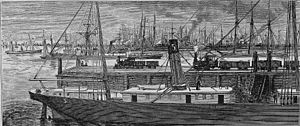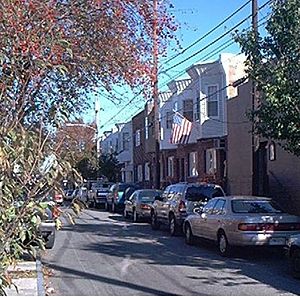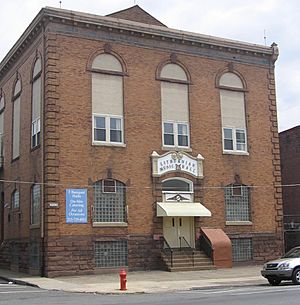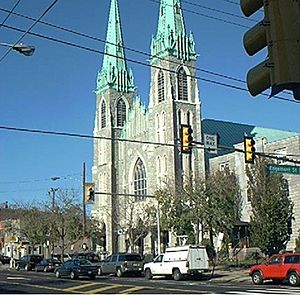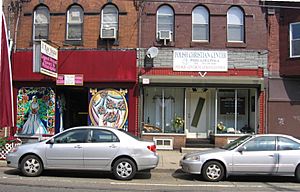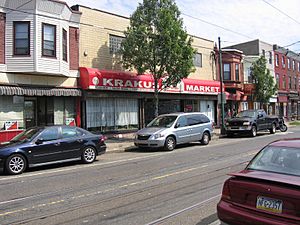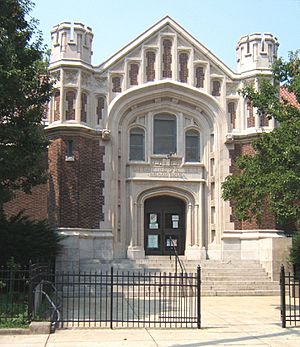Port Richmond, Philadelphia facts for kids
Quick facts for kids
Port Richmond
|
|
|---|---|
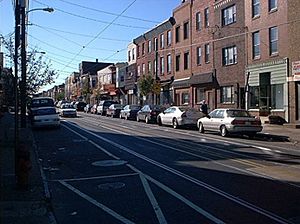
Richmond Street, one of the area's main thoroughfares (2005).
|
|
| Country | |
| State | Pennsylvania |
| County | Philadelphia |
| City | Philadelphia |
| Area code(s) | 215, 267 and 445 |
Port Richmond is a lively neighborhood in Philadelphia, Pennsylvania. It's famous for its very large Polish community, so much so that people often call it Little Poland. Many Polish American families live here. The neighborhood also has a lot of Irish American people, plus German, Lithuanian, Italian, and Puerto Rican families. In recent years, more Albanian families have moved in too. The main ZIP code for Port Richmond is 19134.
This neighborhood is located near the Delaware River. It's bordered by Frankford Creek to the northeast and Lehigh Avenue to the southwest. Kensington and Allegheny Avenues are to the northwest. Nearby neighborhoods include Bridesburg and Kensington.
Contents
Port Richmond's Past
Early Days and Coal Shipping
Long ago, in colonial times, a lot of the land that is now Port Richmond belonged to Anthony Palmer. He was the person who started the Kensington neighborhood in Philadelphia. Palmer bought different pieces of land starting in 1704. He called his large property "Hope Farm." In 1729, he sold it to William Ball. Later, some factories started up in the southern part of "Hope Farm." This area became known as Balltown. Glass and textile factories were there in the late 1700s.
In the 1800s, when steam engines became popular on ships, Port Richmond became a very important place. It was a major stop for colliers, which were ships that carried coal. These ships would pick up coal from the Reading Railroad at the port. Then, they would take the coal to steamships in other places. Colliers and other ships kept coming to Port Richmond for coal until after World War I. That's when ships started using oil and diesel engines instead of coal.
Life in the Early 1900s
At the start of the 1900s, Port Richmond was a place where many working-class families lived. Most people walked to their jobs nearby, often carrying a lunch pail. Cars were not common back then. People who owned cars kept them in stables, just like horses. Streets were usually clear of parked cars. This made it easy for hucksters (street sellers) to drive their horse-drawn wagons down the narrow side streets every day. They sold goods to families.
Many European immigrants came to Port Richmond during this time. They worked hard and saved money to buy small row homes. These homes, like those on Chatham Street, were often heated by a coal-fired range in the kitchen. The rooms were small, usually two downstairs and two upstairs, which made them easier to keep warm. These homes were about twelve feet wide and twenty-four feet long. Their cellars often had dirt floors. Because they were row homes, sharing walls with neighbors, they stayed warmer in winter.
A ton of coal cost about four or five dollars back then. This amount could last a whole winter. However, most people bought coal by the bucket from a street peddler. This peddler would come by daily with his horse-drawn cart. The outside of these homes had wooden steps and brick sidewalks. The bricks in the sidewalks were laid in sand.
Later, row homes in Port Richmond became bigger. Homes on Almond Street, for example, were often sixteen feet wide. They had a cement cellar and a coal-fired furnace for central heat. These newer homes usually had three bedrooms and a bathroom upstairs. Downstairs, they had a living room, dining room, and a kitchen.
Port Richmond families were careful with their money. They bought fresh food from street vendors. These vendors came daily with carts full of vegetables from nearby farms. Housewives could buy cabbage, cucumbers, potatoes, and apples by the bushel. They would store or preserve them for the winter. The city of Philadelphia installed gas pipes in the neighborhood. Gas was used for cooking and lighting. There was a gas meter in the basement. Someone had to put coins into it to keep the gas flowing. Tall gas lamps lit up the streets. Every evening, a lamplighter would come by to light them with a long stick.
Port Richmond's Role in Wars
Port Richmond played a big part in American wars, from the American Revolution all the way through World War II. The William Cramp & Sons Shipbuilding Company, started in 1830, was located nearby. Many local workers found jobs there. They built important ships like the battleships USS Indiana and the USS Massachusetts for the Spanish–American War in the late 1800s. The shipyard also built ships during the American Civil War and during World War I and World War II. During World War II, Cramps' shipyard had 18,000 skilled workers.
During World War II, Port Richmond had many docks and wharves. These were used for loading and unloading war supplies. The area also had many warehouses and workshops. The Reading Railroad used the port to move coal. During the war, the railroad was very important for quickly moving goods to and from the port. Today, the port is smaller, but some shipping services still exist, like the Tioga Marine Terminal.
Train Accidents at Frankford Junction
Frankford Junction in Port Richmond is a key point on the Northeast Corridor rail line. It has also been the site of some major train accidents. On September 6, 1943, a passenger train called the Congressional Limited derailed near Port Richmond. This accident killed 79 people and injured 117 others. On May 12, 2015, an Amtrak train derailed at the same location.
Community and Culture
Port Richmond is a lively neighborhood with a rich history that spans centuries. Many homes have been updated. More young people are moving in. They don't walk to the old docks or factories anymore. Instead, they work in different parts of Philadelphia. They come home in the evenings to their charming neighborhood. Because the side streets are narrow (designed for horses and buggies), parking cars can be a challenge.
Several schools in the area are listed on the National Register of Historic Places. These include the Russell H. Conwell School and the Richmond School.
Polish Heritage in Port Richmond
Port Richmond has many Polish delis and restaurants. This shows the strong Polish background of the neighborhood. The area continues to welcome Polish immigrants.
In the late 1800s and early 1900s, many Polish people moved to Port Richmond. The Polish population grew a lot. They built rowhouses with their famous marble steps. They also built Saint Adalbert Church, which is in the Polish Cathedral style.
Today, you can find many Polish-American restaurants and stores around Richmond Street and Allegheny Avenue. The former Krakus Market on Richmond Street used to sell a large variety of Polish foods. This included different kinds of Kielbasa, Polish canned goods, newspapers, and pastries like Babka and Paczki. Philadelphia's famous Polish American String Band marches in the Mummers Parade on New Year's Day. Sometimes, they also march through Port Richmond for events like Memorial Day.
A few blocks west of Richmond Street on Allegheny Avenue is Campbell's Square. This old park is where neighborhood children play. Special community events are sometimes held there too.
Even though Port Richmond has strong Polish roots, it has also welcomed other groups, like the Lithuanians. Lithuanians have always been connected to the Polish nation. They hold their festivals and dances at the Lithuanian Dance Hall on Allegheny Avenue. The Lithuanian Music Hall is also home to the Theatre Company of Port Richmond. This group has been providing entertainment to the community since 1984.
Neighborhood Demographics
Port Richmond has been a working-class Polish American community for many years. In 2010, about 76.7% of the people were non-Hispanic white. Other groups included Hispanic (14.7%), non-Hispanic black (5.8%), and Asian (1.8%). More recent estimates show the community is becoming more diverse. For example, the 19134 ZIP code has many Puerto Rican and Polish American residents. Like many old neighborhoods, Port Richmond is changing quickly.
Main Streets and Travel
The main streets in Port Richmond are Allegheny Avenue, which runs east and west, and Richmond Street and Aramingo Avenue, which run north and south.
Allegheny Avenue is where you'll find the largest Catholic church in the area, Nativity B.V.M. Our Lady Help of Christians Church is also there. Children from these churches and St. Adalbert's go to Our Lady of Port Richmond Regional Catholic School.
Richmond Street, south of Allegheny Avenue, runs next to Interstate 95. It has many Polish shops that serve the local Polish community. Italian and Polish bakeries here bake fresh bread and traditional pastries.
Port Richmond is also known for the trolley tracks on Richmond Street. These trolleys have recently been fixed and are running again.
Center City Philadelphia, with its big stores and historic places, is not far away. You can get on Interstate 95 from Allegheny Avenue. I-95 can quickly take you to Center City, South Philadelphia, or the Philadelphia International Airport. If you want to see the old buildings of Old City, Philadelphia, you can drive south on Richmond Street. Then, continue south on Delaware Avenue. This drive gives you a great view of what's left of the ship terminals that once made the Port of Philadelphia a busy seaport.
The Port Richmond Trail is part of the East Coast Greenway, a path for walking and biking.
Places of Worship
Nativity of the Blessed Virgin Mary Catholic Church opened in 1882. Two other churches, St. Adalbert in Philadelphia and Our Lady Help of Christians, opened later. In 2019, St. Adalbert, Nativity BVM, and Saint George Parish joined together. St. Adalbert became the main church for the new group, which was renamed St. John Paul II Parish. Our Lady Help of Christians Church closed in 2018.
Schools and Learning
The School District of Philadelphia runs the public schools in Port Richmond.
Our Lady of Port Richmond Regional School started in 2008. It was formed by combining three schools: Nativity B.V.M, Our Lady Help of Christians, and St. Adalbert. Each of these schools had about 200 students. They merged because of money problems in 2008. The new school had 545 students at first, but enrollment went down for a while. By 2016, about 400 students were attending, and numbers were starting to go up again.
The Free Library of Philadelphia has a branch in Port Richmond called the Richmond Branch. In November 2024, the library had to close temporarily because of heating problems. The building had more issues later, including problems with the roof, which caused it to close again after a short reopening.
Famous People from Port Richmond
- Joe Augustyn: An author and screenwriter. He wrote and produced the horror film Night of the Demons. He now writes novels.
- Frank Hoerst: A famous baseball player. He played for the Philadelphia Phillies.
- Jack McTamney: A singer, songwriter, and performer.


